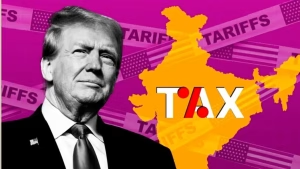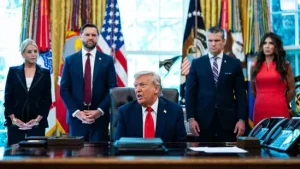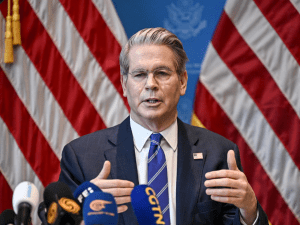Washington D.C. – US President Donald Trump escalated criticism of India-US trade relations Monday, characterizing the bilateral relationship as “totally one-sided” while claiming India has offered to eliminate tariffs. The statement regarding Trump On India Tariff policies came as Prime Minister Narendra Modi met with Russian President Vladimir Putin and Chinese President Xi Jinping at the Shanghai Cooperation Organisation summit.
Trump’s latest commentary on Trump On India Tariff issues emphasizes growing frustration with what Washington perceives as unequal trade arrangements. The President’s assertion that India offered zero tariffs but “it’s getting late” signals potential missed opportunities in bilateral negotiations.
The timing of Trump On India Tariff criticism, coinciding with Modi’s meetings with Putin and Xi Jinping, suggests broader concerns about India’s strategic alignments and trade relationships with countries Washington considers adversaries.
Trade Imbalance and Economic Relations Analysis

Trump described the current India-US trade dynamic as fundamentally imbalanced, stating that while America conducts minimal business with India, New Delhi maintains substantial exports to the United States. This perspective on Trump On India Tariff arrangements reflects longstanding American concerns about trade deficit issues.
The President’s characterization of India as America’s biggest client while the US sells them “very little” forms the foundation for Trump On India Tariff policy justifications. This trade imbalance narrative has been central to Trump’s economic nationalism approach throughout his presidency.
According to Trump’s analysis of Trump On India Tariff dynamics, this one-sided relationship has persisted for decades, requiring immediate correction through enhanced American market access and reciprocal trade arrangements.
Indonesia Comparison and Trade Deal Framework


Trump previously suggested an “Indonesia-style deal” as a potential framework for resolving Trump On India Tariff disputes. This arrangement would leave India facing 19% tariffs while US exporters encounter zero tariffs in Indian markets, creating heavily skewed trade advantages for American businesses.
However, such lopsided agreements represent political red lines for Indian trade negotiators, who have consistently rejected proposals that would create Trump On India Tariff structures favoring American exporters over domestic industries. India’s resistance to asymmetrical trade arrangements reflects sovereignty concerns and economic development priorities.
The Indonesia comparison regarding Trump On India Tariff negotiations demonstrates Trump’s preference for trade deals that explicitly favor American economic interests, even when such arrangements may be politically unacceptable to trading partners.
August Trade Talk Setbacks and Delegation Cancellation


India-US trade negotiations suffered significant setbacks in August when an expected American delegation visit was abruptly cancelled amid rising bilateral tensions. This cancellation directly impacted progress on Trump On India Tariff resolution efforts and broader economic cooperation initiatives.
The August developments followed Trump’s imposition of 50% tariffs on India while criticizing the country’s energy purchases from Russia and existing high tariff structures. These actions regarding Trump On India Tariff policies created substantial obstacles for diplomatic engagement and technical negotiations.
Five negotiation rounds between March and July had largely concluded framework agreements by late June, but talks remained deadlocked over agricultural market access, tariff reciprocity, and ongoing WTO disputes affecting Trump On India Tariff arrangements.
Core Negotiation Issues and Deadlock Factors
Three fundamental issues have prevented resolution of Trump On India Tariff disputes: agricultural market access, comprehensive tariff reciprocity, and World Trade Organization dispute resolution. These complex challenges require careful balance between American economic interests and Indian development priorities.
Agricultural market access remains particularly contentious in Trump On India Tariff negotiations, with American exporters seeking enhanced opportunities while Indian policymakers protect domestic farming communities. This tension reflects broader challenges in modern trade diplomacy.
WTO disputes complicate Trump On India Tariff resolution efforts by creating legal frameworks that constrain bilateral negotiation flexibility. These multilateral obligations influence how both countries approach tariff reduction and market access agreements.
White House Pressure Campaign and Administration Officials


Senior Trump administration officials have intensified public pressure on New Delhi regarding various policy issues, including Trump On India Tariff arrangements and Russian energy purchases. White House deputy chief of staff Stephen Miller, Treasury Secretary Scott Bessent, and senior trade adviser Peter Navarro have publicly criticized Indian policies.
This coordinated pressure campaign regarding Trump On India Tariff issues demonstrates whole-of-government approach to compelling Indian policy changes. Multiple high-level officials reinforcing similar messages suggests strategic communication coordination within the Trump administration.
The public nature of criticism about Trump On India Tariff policies and Russian energy purchases indicates deliberate escalation rather than private diplomatic pressure, potentially complicating future negotiation efforts.
Pakistan Ceasefire and Bilateral Relationship Complications
Trump’s displeasure with India extends beyond Trump On India Tariff issues to include India’s alleged failure to credit the US President for the May ceasefire with Pakistan. This broader frustration encompasses multiple dimensions of bilateral relations rather than focusing exclusively on trade matters.
The combination of Trump On India Tariff disputes with geopolitical disagreements about Pakistan relations suggests comprehensive deterioration in India-US strategic partnership. Multiple friction points complicate efforts to resolve individual issues through isolated negotiations.
These broader relationship challenges make Trump On India Tariff resolution more difficult by creating political context where compromise appears as weakness rather than pragmatic diplomacy.
Quad Summit Cancellation and Strategic Implications
Reports indicate Trump no longer plans to travel to India for the Quad leaders’ summit scheduled later this year, directly linking Trump On India Tariff disputes to broader strategic cooperation frameworks. This cancellation signals serious deterioration in bilateral relations.
The Quad summit cancellation affects Trump On India Tariff resolution prospects by removing high-level diplomatic opportunities for comprehensive agreement. Summit meetings typically provide political momentum for resolving technical trade disputes.
Strategic partnership implications of Trump On India Tariff disputes extend beyond bilateral economic relations to encompass regional security cooperation and multilateral diplomatic initiatives involving Australia and Japan.
Conclusion: Escalating Trade Tensions and Future Prospects
The escalation of Trump On India Tariff rhetoric and policy implementation reflects fundamental challenges in modern trade diplomacy between developed and developing economies. Trump’s characterization of Indian zero-tariff offers as “too late” suggests limited patience for prolonged negotiations.
Future resolution of Trump On India Sanctions disputes requires addressing underlying structural issues including trade imbalances, agricultural market access, and WTO compliance frameworks. The complexity of these challenges suggests continued tension absent significant policy shifts from both Washington and New Delhi.
As bilateral relations face multiple pressure points beyond Trump On India Tariff issues, successful resolution will require comprehensive diplomatic engagement addressing trade, security, and strategic partnership concerns simultaneously.

